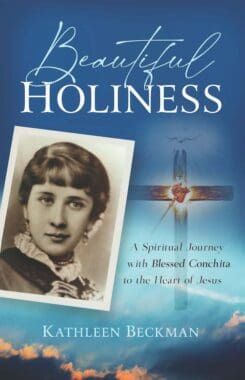The Art of Prayer
Conchita learned the art of prayer from a young age growing up in a pious family. As a child, she felt as though Jesus had stolen her heart.
From my tenderest childhood, I felt in my soul a strong inclination toward prayer, penance, and, above all, purity. Penance was always a joy as far back as I could remember (Aut., 15–16).
While riding about the countryside with my father and my sister Clara, I spend hours reflecting on how I could manage to live in a mountain cave all by myself, far from everyone, giving myself up to penance and prayer whenever the spirit moved me. I was delighted at the thought and pondered it in my heart.
– A Mother’s Spiritual Diary, 6, 7
Conchita was already thinking in terms of solitude, silence, penance, prayer, and how the spirit moves her. Her young soul experienced the delights of God and understood what it is to ponder Him in her heart. Prayer and penance were coupled for Conchita.
In her teens, both her parents and Jesus encouraged Conchita to attend the dances in her hometown together with other teenagers. Conchita learned valuable lessons at the dances:
At the heart of this ocean of vanities and festivals, I felt within my soul a burning desire to learn how to pray. I inquired, I read, I kept myself as much as I could in God’s presence. This was enough to begin seeing a great light shed on the nothingness of worldly things, on the vanity of existence, on the beauty of God. I felt a great love for the Holy Spirit.
– A Mother’s Spiritual Diary, 10
Conchita already knew how to keep herself in the presence of God.
We meet mystics in Scripture. Jesus Christ, Mary, and Joseph are all mystics. In the Gospels we find Jesus praying the prayers of blessing and healing, prayers of thanksgiving to His Father, the prayer of meditation, contemplation, the prayer of tears, the prayer of agony on the Cross, the prayer of surrender at the end of His life. It isn’t surprising that Jesus desires His disciples to become mystics.
Saints paint a portrait of prayer as lofty as the heavens and as practical as picking up our cross daily. Consider the “nada” of St. John of the Cross; the “mansions” of Teresa of Ávila, the “confessions” of St. Augustine, the “devout life” of St. Francis de Sales, the “little way” of St. Thérèse of Lisieux, the “dialogue” of St. Catherine of Siena, the “poverty” of St. Francis of Assisi, the “exercises” of St. Ignatius of Loyola, the “consecration” of St. Louis de Montfort, the “trust” of St. Faustina, the “mercy” of St. John Paul II, and Conchita’s “Love Crucified.” Saints have left us schools of prayer. Blessed Conchita deposited into the Church’s treasury a legacy of prayer.
Conchita’s Prayer
Prayer formed and informed Conchita’s abiding communion with Christ Jesus. She didn’t compartmentalize prayer, works, sacrifices, the duties of her vocation, and apostolates. All that Conchita was and did was clothed in prayer and crowned with love of God. For us, she is a spiritual mother who teaches us to pray with great confidence based on God’s goodness—with lively trust in the promises of Jesus.
What promises about prayer did Our Lord make? Here are just three:
- “Ask, and it will be given you; seek, and you will find; knock, and it will be opened to you. For every one who asks receives, and he who seeks finds, and to him who knocks it will be opened.” (Matt 7:7–8).
- “The Lord is far from the wicked, but he hears the prayer of the righteous” (Prov. 15:29).
- “If you abide in me, and my words abide in you, ask whatever you will, and it shall be done for you” (John 15:7).
For Conchita, prayer was like breathing. It was the organic extension of her soul resting in God, loving Him, talking to Him, enjoying His friendship, walking with Him daily on a journey Heavenward. Daily Eucharist was foundational. I don’t think it’s a stretch to say that Conchita’s life was a continuous act of loving God, but that’s not to say that she didn’t have a prayer regimen.
Conchita’s Diary and her biographers paint a rich picture of her prayer life. Some spiritual practices included attending daily Mass, daily vocal and mental prayer, hidden hours of nocturnal prayer vigils, annual retreats, Ignatian Spiritual Exercises, and meditation on Scripture and on the lives of the saints. Her ascetical practices include sleeping on the hard floor, wearing a hair shirt for reparation, and fasting often on toast and coffee. These were always done with the permission of her spiritual director. She desired to be one with Jesus in every way, discovering Him in people and in history.
Conchita explained that, when we are in the state of grace, our prayers have great efficacy:
A soul in the state of grace always reflects God. Every created soul, as by a divine instinct, and without realizing it, bears within itself the reflection of the Trinity and traces of its unity. But the soul who has simplified itself by the exercise of the virtues, the soul who has allowed itself to be formed by the Holy Spirit, without resisting Him, the soul who because of the degree of transformation along which it has advanced, has torn aside the veils that hid God from its view and has traveled the road of thorns which separated it from Him, who has focused itself upon the Divinity unifying itself, becomes like a mirror which, before the image of the Divinity, copies, reads, understands, and can transmit to the world the echoes of heaven.
– Concepción Cabrera de Armida, Prayer
A person of abiding prayer can “transmit to the world the echoes of heaven.” The world cries out for some echoes of Heaven. Prayer is meant to be a transformative experience, so we become authentic heralds of the living Christ. We need not be a master catechist, apologist, or theologian to transmit to the world echoes of Heaven, but we are called to be authentic witnesses infused with prayer.
Absent prayer, we lose touch with our heart and with reality. We lose sight of God. We lose our spiritual compass. If we don’t fill our minds with prayer, our thoughts will become filled with anxiety, resentments, and lies. Prayer is an elixir of truth that orders the soul to God.
Conchita does not address prayer like a theologian. Hers is the voice of experiential knowledge—an authentic mysticism rooted in Jesus’ school of prayer. Conchita became imbued with prayer through the indwelt Holy Spirit. Jesus ordained Conchita’s prayer life to be suited to her prophetic mission in the Church. Her prayer, led by the Holy Spirit, was Trinitarian, Marian, Eucharistic, missionary for the Church, rooted in the Cross. Her prayer life was the flowering of her baptismal priesthood.
The Cross was Conchita’s standard by God’s design and her ardent will to be united with Jesus in every way . Her prayers center on the perfect sacrifice of the pierced Heart of Jesus. The sword that pierced the Heart of Jesus on the Cross opened Heaven. Jesus prayed on the altar of the Cross; His victory sprang forth from its crossbeams. Conchita believed what Paul taught, “For the word of the cross is folly to those who are perishing, but to us who are being saved it is the power of God” (1 Cor. 1:18). Jesus taught Conchita about the dynamism of divine love at work on the Cross. She understood that Love crucified is the bridge to resurrected life.
+
This article on how to enter the narrow gate is adapted from a chapter in Beautiful Holiness by Fr. Kathleen Beckman which is available from Sophia Institute Press.
Art for this post: Cover and featured image used with permission.





